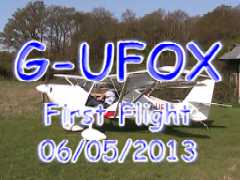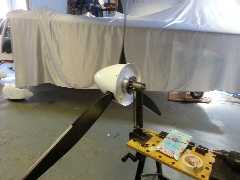G-UFOX
- First Flight
The big day is here!
Roger and Adrian have been at the Popham
Microlight Trade Fair this weekend which leaves Bank Holiday Monday with Adrian
in the area, and the possibility of the first flight.

 The
plane is finished and we check it over, clean it and fuel it - all good. Adrian
flies G-ETUG (one of Roger's demonstrators) to our airfield and stays over so
that we can make an early start in the morning. Anyone who knows me will testify
that early mornings are not my thing, but we are at the hangar at 7 am. After
tea, Adrian completes the checks and paperwork, the engine is started and warmed.
The
plane is finished and we check it over, clean it and fuel it - all good. Adrian
flies G-ETUG (one of Roger's demonstrators) to our airfield and stays over so
that we can make an early start in the morning. Anyone who knows me will testify
that early mornings are not my thing, but we are at the hangar at 7 am. After
tea, Adrian completes the checks and paperwork, the engine is started and warmed.
He starts by testing the ground handling
- up and down the runway and twisting around like a demented bee. Tom is away
in America, but the other three of us are standing around like nervous parents. However, unfortunately all is not as good as we hoped. There seems to be some
vibration at certain engine speeds. Once satisfied that everything else is OK
and it is safe to do so, he takes off and heads off for Popham.
However, unfortunately all is not as good as we hoped. There seems to be some
vibration at certain engine speeds. Once satisfied that everything else is OK
and it is safe to do so, he takes off and heads off for Popham.  It's
a little hard to describe the feeling you get when your baby leaves terra-firma
and takes to the sky - just magic. We follow on by car.
It's
a little hard to describe the feeling you get when your baby leaves terra-firma
and takes to the sky - just magic. We follow on by car.
Popham is a more suitable venue for testing
than our airfield. However, today there is an Aero and Auto Jumble Event along
with a Classic Vehicle Rally and a Fly-In - in short - it's busy. When we get
there, obviously G-UFOX has already arrived. We take it round the back to start
looking at the vibration problem.
The suspicion is that one propeller blade
is at a slightly different angle to the others causing an imbalance. We borrow
an accurate prop pitch gauge (thanks Greg) and check them - they are spot-on.
This is good that we did them right, but bad that it's not an easy fix for our
problem. Adrian lines up for another test flight.
The trouble is that it is quite a subjective
thing, so he lands and then takes me up. We take off from the intersection (to
avoid putting dust on the helicopter parked at the threshold) and are quickly
airborne - what a feeling - the deep glazed doors giving a good view as we climb
out. Great feeling - but back to the job in hand. It's not right - it does vibrate
excessively, particularly at about 3700 rpm.
Back on the ground, we decide to try the
trick of moving the prop round one blade - not sure how, but apparently it can
help (thanks again Greg for lending some more tools). Adrian thinks it is a
bit better, but I'm not convinced. So back up in the air and it proves to still
be unacceptable.
 So
we take it to Roger's place and put it on his new fancy prop balancer he got
from AeroPro. The prop is bolted onto the jig complete with it's aluminium spacer
and spinner - the whole lot gets balanced together. The shaft is mounted horizontally
so that gravity will pull the heaviest part downwards The bearings are heated
to reduce the friction.
So
we take it to Roger's place and put it on his new fancy prop balancer he got
from AeroPro. The prop is bolted onto the jig complete with it's aluminium spacer
and spinner - the whole lot gets balanced together. The shaft is mounted horizontally
so that gravity will pull the heaviest part downwards The bearings are heated
to reduce the friction.  An
extra shaft is attach to a bearing concentric with the main bearing via an eccentric.
The shaft is attached to an electric drill, so that the eccentric will vibrate
the bearing to and fro which effectively kills the stiction. Once assembled,
the drill is run and the prop readily swings round - so it is out of balance!
Clearly our attempts to balance it were not very effective. We start sticking
weights onto the spinner flange using masking tape and iteratively move then
around (and trim one of them) until the assembly no longer moves. The weighs
positions are then carefully marked and then they are stuck, drilled and riveted
to the spinner flange. After a final test, we return it to the aircraft and
bolt it back on. A ground test shown a dramatic improvement so we take off and
indeed it is now fixed - hooray (and phew!).
An
extra shaft is attach to a bearing concentric with the main bearing via an eccentric.
The shaft is attached to an electric drill, so that the eccentric will vibrate
the bearing to and fro which effectively kills the stiction. Once assembled,
the drill is run and the prop readily swings round - so it is out of balance!
Clearly our attempts to balance it were not very effective. We start sticking
weights onto the spinner flange using masking tape and iteratively move then
around (and trim one of them) until the assembly no longer moves. The weighs
positions are then carefully marked and then they are stuck, drilled and riveted
to the spinner flange. After a final test, we return it to the aircraft and
bolt it back on. A ground test shown a dramatic improvement so we take off and
indeed it is now fixed - hooray (and phew!).
So Rogers vibrating tool has fixed our
vibration problem!
We have lost a lot of time, but we start
to do the ASI calibration runs. Inspecting the GPS speed over ground we yaw
the plane gently until we find the into-wind direction (minimum GPS speed).
Then holding this course we fly at 50 knots whilst I read out the GPS speed.
Having made a note of this speed (with indicated at 50 knots), we then repeat
at 60 knots. Then 70, 80 90 and 100 knots. It's a bit too thermally at the moment
to do the final measurement. Then we turn around and repeat the measurements
downwind - the GPS track helps us ensure we are going in the inverse direction.
Assuming the wind hasn't changed too much, the average will give us the calibrated
airspeed to apply the correction to the ASI. We then do the 40knot measurement
with some flap applied. The we go for a bit of a flight (to Charmy Down) and
then back to Popham.
That's all we have time for, so Adrian
takes her back to our hangar. We clean off all the millions of flies that have
expired on the wings, struts and cowling. Shame we couldn' have completed the
testing but that is a tall order even without the balance problems. Adrian is
in Slovakia this week so we are hoping we can continue next week, if the weather
is obliging.
One thing that has become evident is that
the oil cooler flap is essential.
Return to main index page

 The
plane is finished and we check it over, clean it and fuel it - all good. Adrian
flies G-ETUG (one of Roger's demonstrators) to our airfield and stays over so
that we can make an early start in the morning. Anyone who knows me will testify
that early mornings are not my thing, but we are at the hangar at 7 am. After
tea, Adrian completes the checks and paperwork, the engine is started and warmed.
The
plane is finished and we check it over, clean it and fuel it - all good. Adrian
flies G-ETUG (one of Roger's demonstrators) to our airfield and stays over so
that we can make an early start in the morning. Anyone who knows me will testify
that early mornings are not my thing, but we are at the hangar at 7 am. After
tea, Adrian completes the checks and paperwork, the engine is started and warmed.


